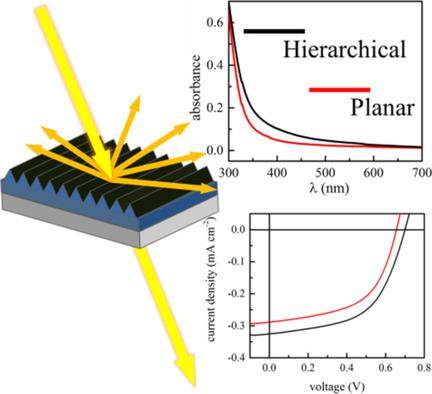当前位置:
X-MOL 学术
›
ChemSusChem
›
论文详情
Our official English website, www.x-mol.net, welcomes your feedback! (Note: you will need to create a separate account there.)
Wet Imprinting of Channel‐Type Superstructures in Nanostructured Titania Thin Films at Low Temperatures for Hybrid Solar Cells
ChemSusChem ( IF 8.4 ) Pub Date : 2018-03-15 , DOI: 10.1002/cssc.201800129 Lin Song 1 , Tianyi Wang 1, 2 , Volker Körstgens 1 , Weijia Wang 3 , Nitin Saxena 1 , Christoph J. Schaffer 1 , Thomas Fröschl 4 , Nicola Hüsing 4 , Sigrid Bernstorff 5 , Peter Müller-Buschbaum 1
ChemSusChem ( IF 8.4 ) Pub Date : 2018-03-15 , DOI: 10.1002/cssc.201800129 Lin Song 1 , Tianyi Wang 1, 2 , Volker Körstgens 1 , Weijia Wang 3 , Nitin Saxena 1 , Christoph J. Schaffer 1 , Thomas Fröschl 4 , Nicola Hüsing 4 , Sigrid Bernstorff 5 , Peter Müller-Buschbaum 1
Affiliation

|
Hierarchically structured titania films, exhibiting interconnected foam‐like nanostructures and large‐scale channel‐type superstructures, were achieved in an energy‐saving way at low temperatures by a polymer template‐assisted sol–gel synthesis in combination with a wet‐imprinting process. The surface morphology was probed with scanning electron microscopy and atomic force microscopy, whereas the inner morphology was characterized with grazing incidence small‐angle X‐ray scattering measurements. Compared to the initial hybrid films, the titania films showed reduced structure sizes caused by removal of the polymer template. UV/Vis measurements showed an additional light‐scattering effect at various angles of light incidence in the hierarchically structured titania films, which resulted in higher light absorption in the wet‐imprinted active layer. To give proof of viability, the titania films were evaluated as photoanodes for dye‐free hybrid solar cells. The dye‐free layout allowed for low‐cost fabrication, avoided problems related to dye bleaching, and was a more environmentally friendly alternative to using dyes. Under different angles of light incidence, the enhancement in the short‐circuit current density was in good agreement with the improvement in light absorption in the superstructured active layer, demonstrating a positive impact of the superstructures on the photovoltaic performance of hybrid solar cells.
中文翻译:

混合太阳能电池在低温下纳米结构的二氧化钛薄膜中通道型上层结构的湿压印
通过聚合物模板辅助的溶胶-凝胶合成与湿压印工艺相结合,在低温下以节能的方式实现了分层结构的二氧化钛薄膜,这些薄膜表现出相互连接的类似泡沫的纳米结构和大规模的通道型超结构。表面形貌用扫描电子显微镜和原子力显微镜探测,而内部形貌用掠入射小角度X射线散射测量表征。与最初的杂化膜相比,二氧化钛膜显示出由于去除聚合物模板而导致的结构尺寸减小。UV / Vis测量显示,在分层结构的二氧化钛薄膜中,不同角度的入射光都具有额外的光散射效果,这导致湿印活性层的光吸收更高。为了证明其可行性,将二氧化钛薄膜作为无染料混合太阳能电池的光阳极进行了评估。无染料布局允许低成本制造,避免了与染料漂白有关的问题,并且是使用染料的更环保的选择。在不同角度的光入射下,短路电流密度的增加与超结构化有源层中光吸收的改善非常吻合,这表明上层结构对混合太阳能电池的光伏性能产生了积极影响。
更新日期:2018-03-15
中文翻译:

混合太阳能电池在低温下纳米结构的二氧化钛薄膜中通道型上层结构的湿压印
通过聚合物模板辅助的溶胶-凝胶合成与湿压印工艺相结合,在低温下以节能的方式实现了分层结构的二氧化钛薄膜,这些薄膜表现出相互连接的类似泡沫的纳米结构和大规模的通道型超结构。表面形貌用扫描电子显微镜和原子力显微镜探测,而内部形貌用掠入射小角度X射线散射测量表征。与最初的杂化膜相比,二氧化钛膜显示出由于去除聚合物模板而导致的结构尺寸减小。UV / Vis测量显示,在分层结构的二氧化钛薄膜中,不同角度的入射光都具有额外的光散射效果,这导致湿印活性层的光吸收更高。为了证明其可行性,将二氧化钛薄膜作为无染料混合太阳能电池的光阳极进行了评估。无染料布局允许低成本制造,避免了与染料漂白有关的问题,并且是使用染料的更环保的选择。在不同角度的光入射下,短路电流密度的增加与超结构化有源层中光吸收的改善非常吻合,这表明上层结构对混合太阳能电池的光伏性能产生了积极影响。



























 京公网安备 11010802027423号
京公网安备 11010802027423号